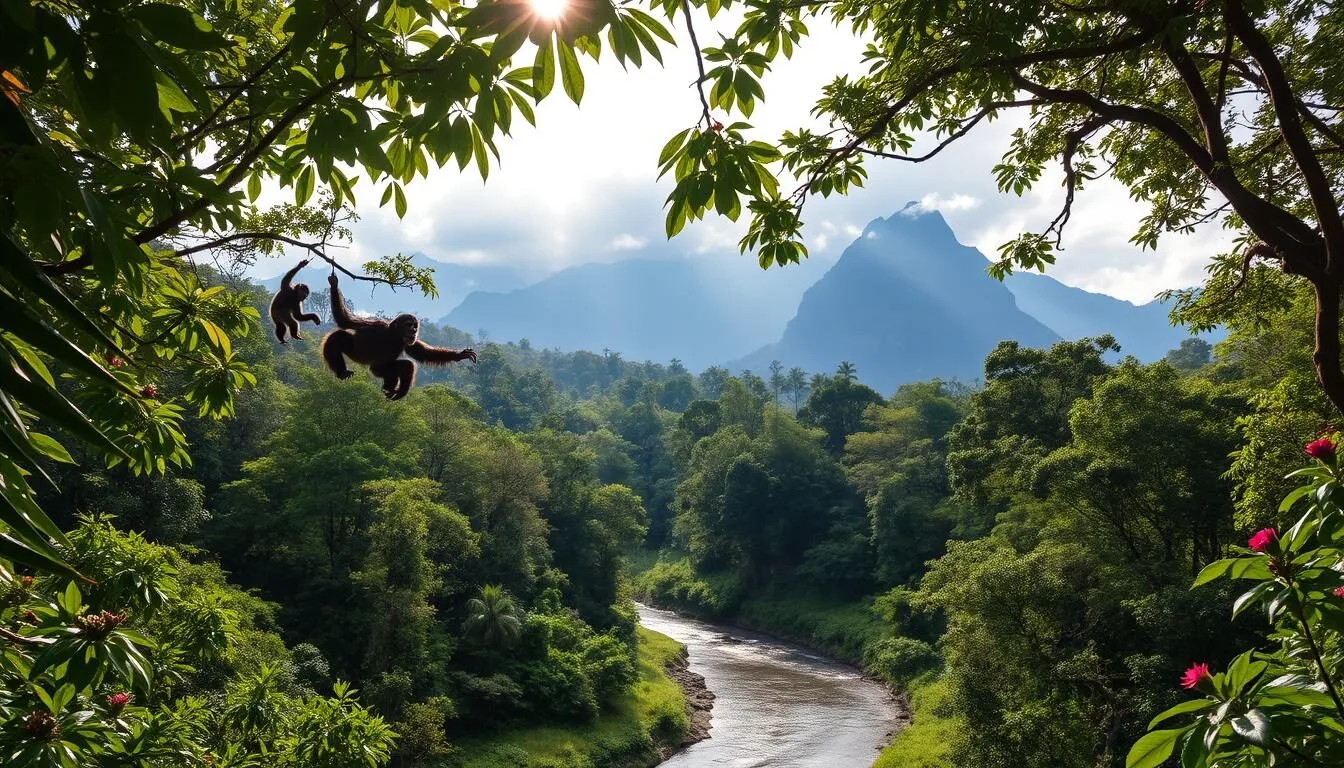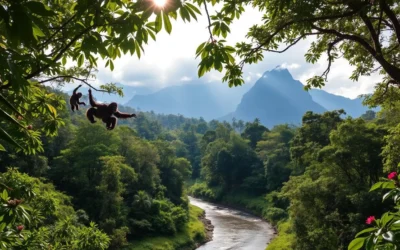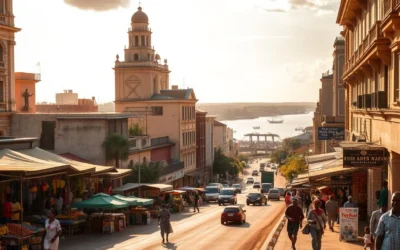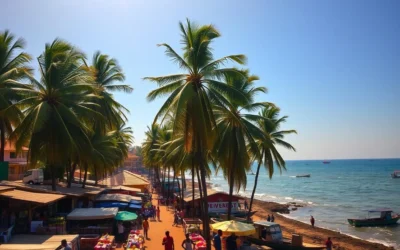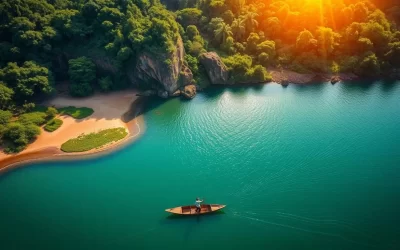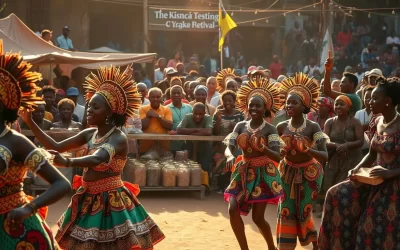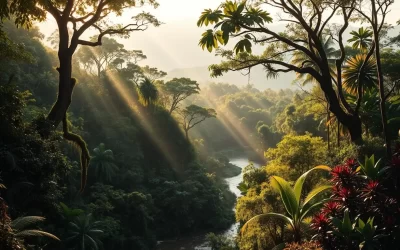You might be surprised to know that the Democratic Republic of Congo is home to Africa’s oldest national park, Virunga, which boasts an incredible array of wildlife, including endangered mountain gorillas.
The country’s vast natural resources and diverse landscapes make it an attractive destination for adventurous travelers. You can experience the mighty Congo River through traditional pirogue trips or longer expeditions, immersing yourself in the local culture and witnessing the breathtaking natural beauty of this world-renowned destination.
As you explore the Democratic Republic of Congo, you’ll discover a vibrant cultural tapestry, from bustling markets to traditional fishing techniques at Boyoma Falls. With its unique blend of wildlife encounters and cultural immersion, this challenging yet rewarding destination is sure to leave a lasting impression.
Discovering the Democratic Republic of Congo
The Democratic Republic of Congo, a country spanning over 2.3 million square kilometers, is a treasure trove of natural wonders and rich cultural heritage waiting to be explored. As the second-largest country in Africa, it is home to a diverse array of ecosystems and cultures that make it a fascinating destination for travelers.

A Land of Natural Wonders and Cultural Diversity
The Democratic Republic of Congo is characterized by its vast and varied landscapes, from the dense rainforests to the volcanic mountains in the east. This diversity in geography has given rise to a wide range of ecosystems, supporting an incredible array of biodiversity. The country is also home to over 250 ethnic groups, each with their own distinct traditions, languages, and artistic expressions, contributing to a rich cultural tapestry.
Congo’s cultural heritage has not only shaped the nation’s identity but has also had a significant influence on global culture. The Congolese people maintain vibrant cultural traditions despite historical conflicts and economic challenges, showcasing their resilience and strength.
Understanding Congo’s Geography and Climate
Congo’s geography is as complex as it is fascinating, with the vast Congo River Basin being a dominant feature. The country’s climate varies significantly by region, with the equatorial zone experiencing rainfall throughout the year, while other areas have distinct wet and dry seasons. Understanding these climatic patterns is crucial for planning a visit to maximize your travel experience.
| Region | Climate | Best Time to Visit |
|---|---|---|
| Equatorial Zone | Rainfall throughout the year | Anytime, but be prepared for rain |
| Southern Regions | Distinct wet and dry seasons | Dry season (May to September) |
| Eastern Highlands | Cooler temperatures, occasional rain | Dry season for trekking and hiking |
Kinshasa, the capital, lies on the southern banks of the Congo River and is a city of contrasts, blending traditional and modern life. The temperature in Kinshasa is generally warm, especially from May to September, making it a great time to explore this vibrant city.
Virunga National Park: Africa’s Oldest National Park
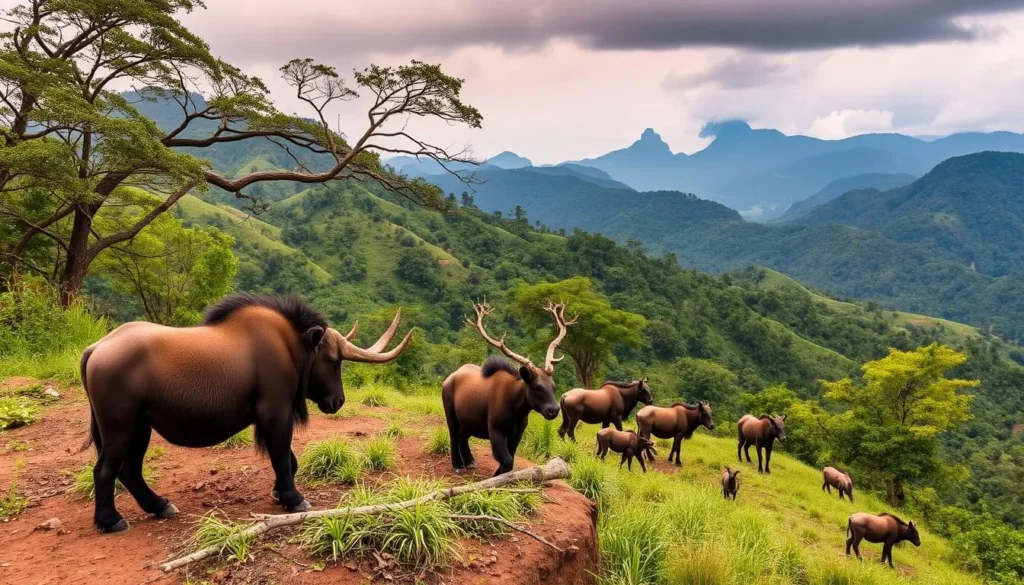
With its establishment dating back to 1925, Virunga National Park is not only Africa’s first national park but also a haven for endangered species. Spanning approximately 7,800 square kilometers, it is a UNESCO World Heritage Site recognized for its exceptional natural beauty and biodiversity.
UNESCO World Heritage Site Features
Virunga National Park is home to a wide range of habitats, including dense forests, savannahs, active volcanoes, and the shores of Lake Edward. This diversity supports a remarkable variety of wildlife, including endangered mountain gorillas, forest elephants, hippos, Okapis, lions, and Bongo. The park’s unique features make it an attractive destination for tourists and a critical area for conservation efforts.
The park shares its borders with other significant conservation areas, such as Queen Elizabeth National Park in Uganda and Volcanoes National Park in Rwanda, creating a vast, interconnected ecosystem.
Conservation Efforts and Visitor Impact
Conservation is at the heart of Virunga National Park’s mission. The park is home to approximately one-third of the world’s remaining mountain gorillas. Efforts to protect these and other species include anti-poaching patrols, community development projects, and habitat protection initiatives, all of which are funded in part by visitor fees.
Visitors to the park not only experience the beauty of Africa’s oldest national park but also contribute directly to its conservation. Activities range from gorilla trekking to volcano hikes, chimpanzee tracking, and bird watching, offering something for every nature lover and adventure seeker.
Gorilla Trekking: A Once-in-a-Lifetime Experience
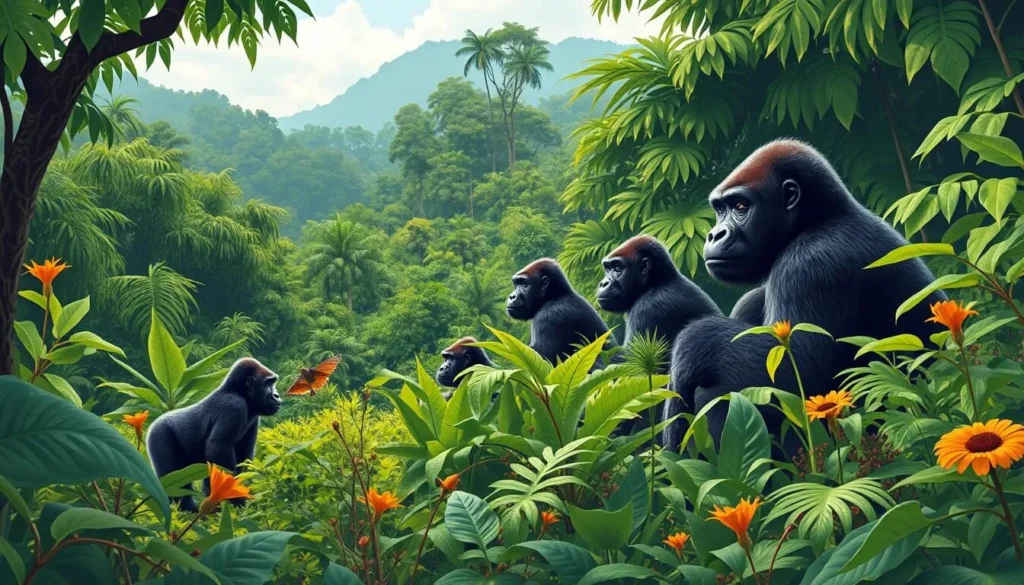
Gorilla trekking in the Democratic Republic of Congo is an unparalleled adventure that brings you face-to-face with these magnificent creatures. In Congo, gorillas can be trekked in Virunga National Park, a UNESCO World Heritage Site.
The activity starts in the morning with a briefing at the park headquarters, after which you’re grouped into 8 individuals to your assigned gorilla family. You will be led by the park rangers into the forest trails in search of them.
Meeting Mountain Gorillas in Their Natural Habitat
Experience the extraordinary privilege of gorilla trekking in Virunga National Park, one of only three places in the world where you can encounter mountain gorillas in their natural habitat. Understand the careful preparation required for gorilla trekking, including securing permits well in advance as only 8 visitors are allowed per gorilla family per day to minimize impact.
Learn about the briefing process at park headquarters where rangers explain gorilla etiquette, safety protocols, and what to expect during your trek through the dense forest.
What to Expect During a Gorilla Trek
Prepare for a physically demanding but incredibly rewarding hike that can last from 30 minutes to 6 hours depending on the gorilla family’s location that day. Discover what happens during your precious one hour with the gorillas, observing their remarkably human-like behaviors, family dynamics, and daily activities from a respectful distance.
Appreciate the conservation impact of your visit, as gorilla tourism provides crucial funding for protection efforts and creates economic opportunities for local communities. Consider combining your gorilla trek with other activities in Virunga National Park for a comprehensive Congo experience that supports wildlife conservation.
- Experience the extraordinary privilege of gorilla trekking in Virunga National Park.
- Understand the careful preparation required for gorilla trekking.
- Learn about the briefing process at park headquarters.
- Prepare for a physically demanding but incredibly rewarding hike.
- Discover what happens during your precious one hour with the gorillas.
- Appreciate the conservation impact of your visit.
- Consider combining your gorilla trek with other activities in Virunga National Park.
Hiking Mount Nyiragongo: Witness an Active Volcano
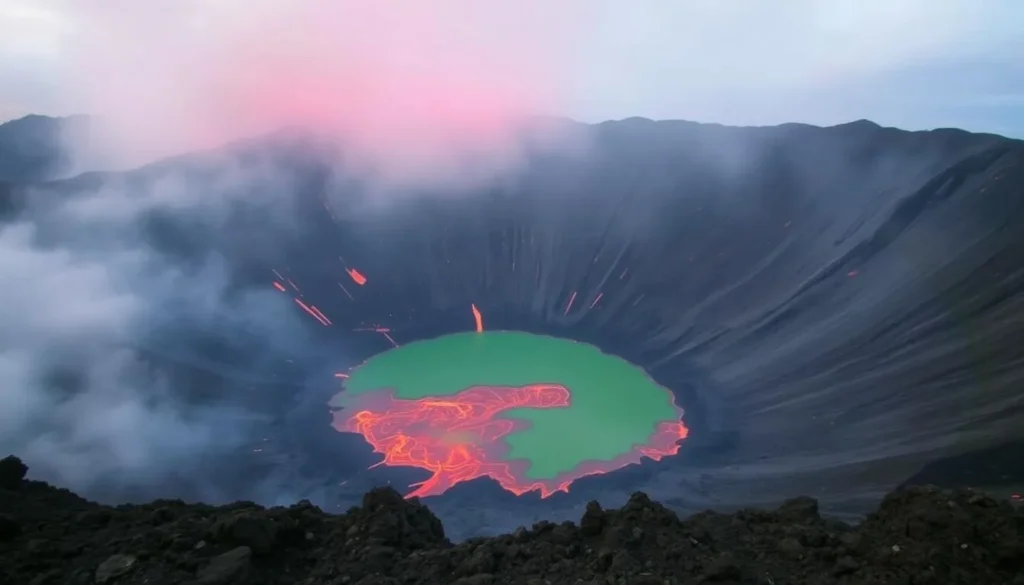
Witness the raw power of nature at Mount Nyiragongo, one of Africa’s most spectacular volcanic landscapes. Located in the Virunga Mountains, this active stratovolcano stands at an elevation of 3,470 meters, offering a challenging yet rewarding hiking experience.
The World’s Largest Lava Lake
Mount Nyiragongo is home to the world’s largest lava lake, a mesmerizing spectacle that illuminates the night sky. The main crater, which is 2 kilometers wide, features this incredible natural wonder. As you hike to the summit, you’ll be surrounded by changing vegetation zones, from lush rainforests at the base to alpine environments near the summit.
The lava lake is a result of the volcano’s unique geology, shaped by dramatic eruptions that have impacted the surrounding landscape and the nearby city of Goma. The volcano’s history is marked by significant events, including the 2002 eruption that devastated parts of Goma, causing loss of life and displacement of hundreds of thousands of people.
Preparing for the Overnight Volcano Trek
To ensure a safe and enjoyable experience, it’s essential to prepare for the challenging 5-6 hour ascent. You can hire a porter at the Kibati Ranger post to help carry your heavy luggage. Pack essential items such as hiking boots, warm clothes, mineral water, and energy-rich snacks.
The overnight experience at the crater rim offers breathtaking views of the bubbling lava lake. Basic cabins provide shelter as you witness the mesmerizing spectacle. This unique experience is a must for adventure-seekers and those interested in volcanology.
As you plan your Mount Nyiragongo hiking tour, consider the Democratic Republic of Congo’s rich history and cultural heritage. The region offers a blend of natural wonders and cultural experiences, making it an ideal destination for travelers.
Congo River Adventures
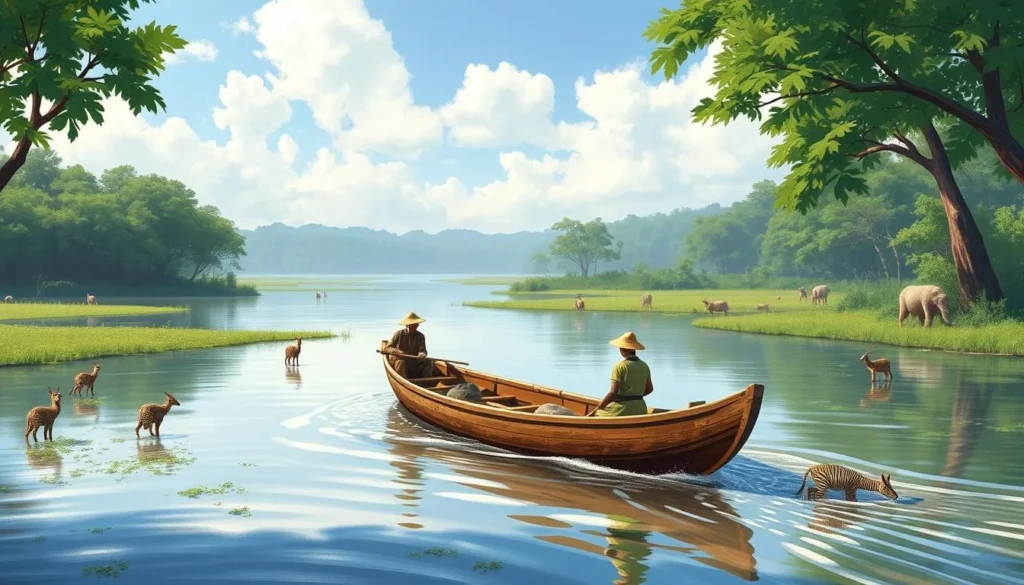
Experience the raw energy of the Congo River, where the rhythm of local life unfolds. As you glide along the river on traditional pirogues, you’ll witness the vibrant daily life of the people living along the riverbanks, gaining a unique perspective of Kisangani city from the water.
The Congo River has played a crucial role in shaping the city’s development as a major port city, serving as the furthest navigable point upstream from Kinshasa. You’ll see fishermen at work, children playing by the river, and women doing their daily chores, all while enjoying the spectacular views of the lush rainforest and riverside villages.
Day Trips on Traditional Pirogues
Day trips on traditional pirogues offer a glimpse into the local way of life along the Congo River. As you navigate the river’s complex network, you’ll observe the rich biodiversity that thrives along its banks. The Congo River is home to over 700 fish species, many of which are found nowhere else on Earth, making it a fascinating place for nature enthusiasts.
- Experience the mighty Congo River, Africa’s second-longest river and the world’s deepest, cutting through the heart of the country and serving as its lifeline for transportation and commerce.
- Discover the unique perspective of Congo from traditional wooden pirogues, hand-carved vessels that have been used by local communities for generations to navigate the river’s complex network.
- Observe daily riverside life during day trips, where you’ll witness fishing activities, villages, and the lush biodiversity that thrives along the river’s banks.
Longer Expeditions Along Africa’s Deepest River
For the more adventurous, consider longer river expeditions, which can range from multi-day journeys to the epic 2-3 week ferry trip between Kisangani and Kinshasa. These journeys offer an authentic way to experience the mighty Congo River and its diverse wildlife, following historical routes once traveled by explorers like Henry Morton Stanley.
- Consider more adventurous multi-day expeditions that follow historical routes once traveled by explorers, offering a deeper immersion into remote areas.
- Learn about the river’s ecological importance as home to over 700 fish species, many found nowhere else on Earth, and its role in sustaining the world’s second-largest rainforest.
- Understand how the Congo River has shaped the country’s history, serving as both a barrier and a highway that influenced settlement patterns, trade routes, and cultural exchanges.
Exploring Boyoma Falls and Kisangani
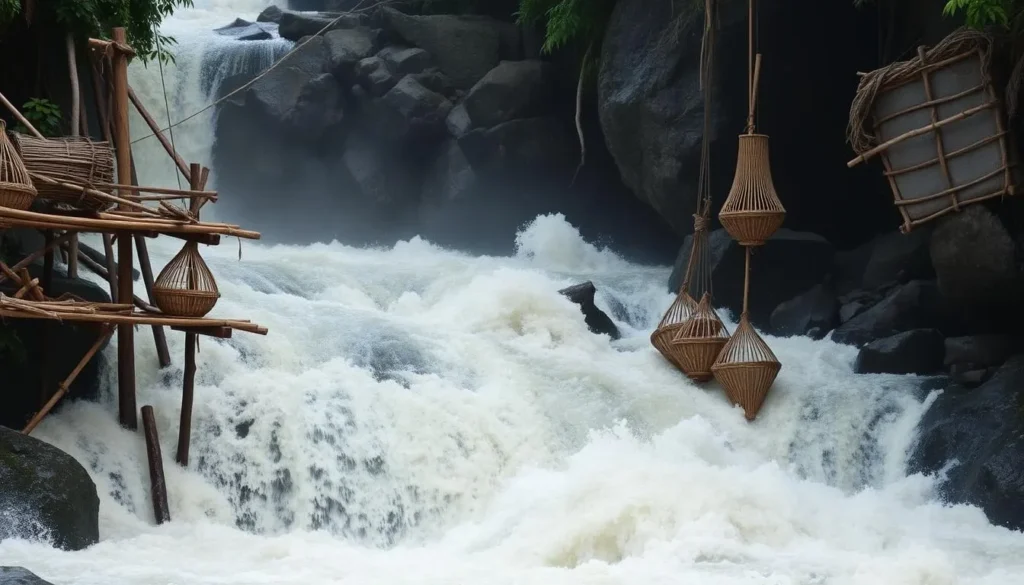
As you venture into the heart of Congo, you’ll discover the breathtaking Boyoma Falls and the vibrant city of Kisangani. Boyoma Falls, formerly known as Stanley Falls, is a series of seven cataracts that stretch over 100 kilometers along the Congo River near Kisangani, creating a spectacular natural spectacle.
Traditional Fishing Techniques at the Falls
The Wagenia fishermen at Boyoma Falls are renowned for their ingenious traditional fishing techniques. They construct and maintain elaborate wooden scaffolding and conical basket traps to catch fish in the powerful rapids. You can witness these traditional methods, which have been passed down through generations, showcasing the deep connection between the local people and the mighty Congo River. The best time to visit is during the drier months (December to February) when water levels are lower, making the wooden structures more visible.
Discovering “The City on the Island”
Kisangani, known as “the city on the island,” is located at the furthest navigable point on the Congo River. With a rich history dating back to its founding by Henry Morton Stanley in 1883, Kisangani has played a significant role throughout Congo’s history. Today, it’s a major commercial hub, connecting river and land transportation networks. The city‘s unique cultural blend is evident in its markets, architecture, and daily life, making it a fascinating place to explore.
Congo: Best Things to Do – Top Picks for Cultural Experiences
From bustling markets to historical landmarks, Congo’s cultural scene is as diverse as it is captivating. As you explore this vibrant country, you’ll discover a rich tapestry of cultural experiences that showcase the best of Congolese life.
Vibrant Local Markets
The local markets of Kisangani offer a sensory experience like no other in the Democratic Republic of Congo. As you navigate through the narrow aisles, you’ll be surrounded by a kaleidoscope of colors, sounds, and aromas. The market is a hub where locals gather to buy and sell everything from fresh produce to handcrafted items, reflecting the city’s rich cultural heritage.
- Discover a variety of fresh tropical fruits, vegetables, nuts, and street food that highlight the local food culture.
- Interact with friendly local merchants and practice your bargaining skills, as haggling is an expected part of the shopping experience.
- Support local artisans by purchasing directly from craftspeople, many of whom continue techniques passed down through generations.
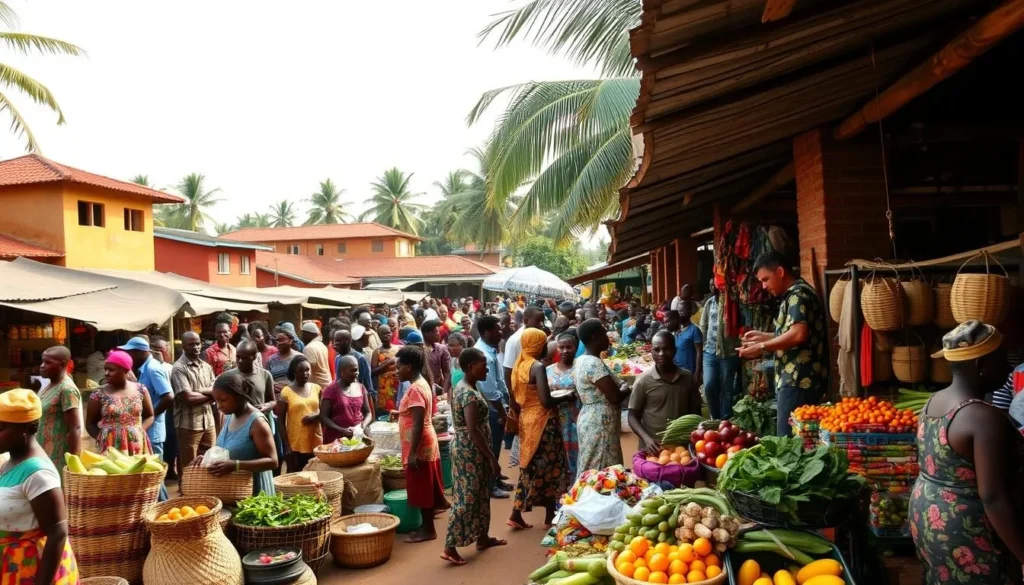
Museums and Historical Sites
Congo is also home to numerous museums and historical sites that offer a glimpse into the country’s rich history and cultural diversity. A visit to the National Museum of Kinshasa (Musée National de Kinshasa) is a must, with its impressive collection of approximately 46,000 objects documenting Congo’s history, diverse ethnic groups, and natural heritage.
- Explore historical sites like Palais de la Nation, built in 1956 as the Belgian governor’s residence, and experience the architectural grandeur of the past.
- Visit religious landmarks such as the Nôtre Dame Cathedral, known for its striking brick and glass architecture.
- Discover the vibrant Congolese music scene, which has influenced sounds across Africa and beyond, with opportunities to enjoy live performances in urban venues.
By engaging with local communities through cultural events and festivals, you’ll gain authentic insights into traditional customs, dances, and ceremonies, enriching your understanding of Congolese culture and people.
Wildlife Encounters Beyond Gorillas
Beyond gorilla trekking, the Democratic Republic of Congo offers a diverse array of wildlife encounters that showcase the country’s rich biodiversity. Visitors to the Democratic Republic of Congo can explore various national parks and protected areas, each offering unique wildlife experiences.
Lola ya Bonobo Sanctuary
Lola ya Bonobo Sanctuary is the world’s only sanctuary for orphaned bonobos, providing a safe haven for these endangered great apes. Located in Kimwenza, outside the city, the sanctuary plays a crucial role in rehabilitating young bonobos rescued from the bushmeat trade.
The sanctuary offers visitors a chance to observe bonobos in a natural setting, learning about the conservation efforts and the challenges faced by these intelligent primates.
Bird Watching and Forest Safaris
Congo is a paradise for birdwatchers, with over 1,000 species recorded across various habitats, from rainforests to savannahs and wetlands. Forest safaris offer the opportunity to explore Kahuzi-Biega National Park, home to eastern lowland gorillas, and the Okapi Wildlife Reserve in the Ituri Forest, where the elusive okapi can be spotted.
Visitors can experience the incredible diversity of Congo’s wildlife by taking guided tours that focus on chimpanzee tracking, forest elephant observation, or exploring the diverse primates that inhabit the country’s varied ecosystems.
Congolese Culinary Delights
Exploring Congolese cuisine is a journey through the country’s history and geography. The local food is a reflection of the nation’s cultural diversity, with influences from African, Belgian, and other local traditions.
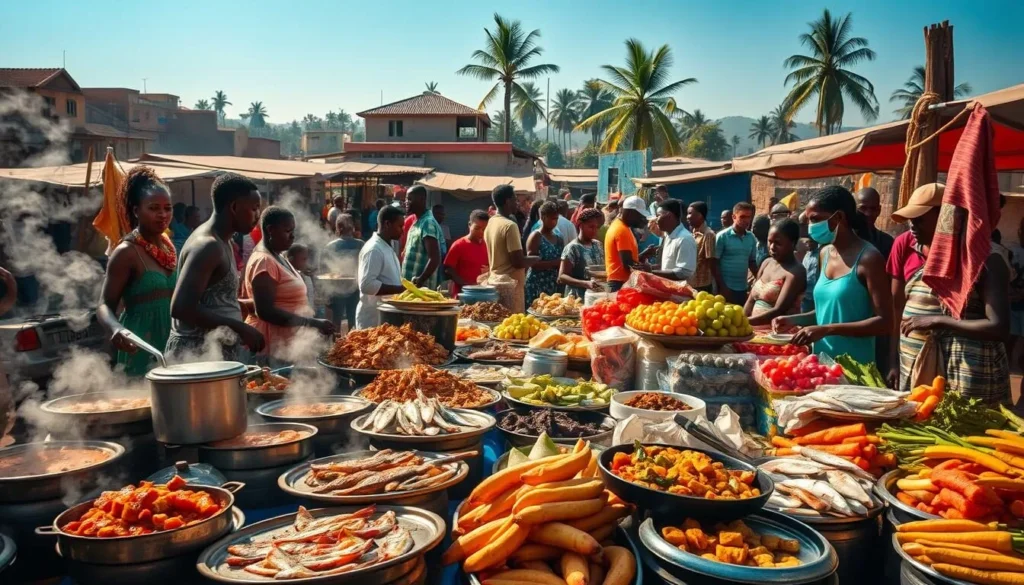
Must-Try Traditional Dishes
Congolese cuisine offers a variety of traditional dishes that are worth trying. Poulet à la Moambé, the national dish, is a flavorful chicken stew made with cassava leaves and palm butter, typically served with fufu or rice. Freshwater fish is also a staple, with various preparations of tilapia and capitaine (Nile perch) from the Congo River.
- Savor Poulet à la Moambé, slow-cooked with cassava leaves and palm butter.
- Experience the importance of freshwater fish in Congolese cuisine.
- Try fufu, a staple starch made from pounded cassava or plantains.
Best Dining Experiences in Major Cities
In major cities like Kinshasa, you’ll find a diverse dining scene. Restaurants such as Chez Flore offer authentic Congolese cuisine, while A Casa Mia and Limoncello serve European-influenced dishes. For a taste of Lebanese cuisine, visit Le Palais.
| Restaurant | Cuisine | Location |
|---|---|---|
| Chez Flore | Congolese | Kinshasa |
| A Casa Mia | European/Congolese | Kinshasa |
| Limoncello | European/Congolese | Kinshasa |
When dining out, be sure to try local beverages like palm wine, Congolese beers (Simba and Bracongo), and refreshing coconut drinks.
Practical Travel Tips for Visiting Congo
As you plan your trip to the Democratic Republic of Congo, it’s essential to be aware of the local conditions and necessary precautions. To ensure a smooth journey,secure your visa well in advance, as it can take several weeks to process.
Travelers should alsoensure they have all required vaccinations, particularly yellow fever, which is mandatory. When planning your itinerary, work with reputable local tour operators who understand current security conditions and can arrange necessary permits for activities like gorilla trekking inVirunga National Park.
When traveling in the Democratic Republic of Congo, be prepared for limited infrastructure outside major cities. It’s also crucial tostay informed about regional security situationsand respect local customs and etiquette. By being mindful of these factors, you can have a safe and enjoyable trip to this vibrant country. Consider your accommodation options carefully, and don’t hesitate to seek advice from trusted locals or your hotel staff when needed.
The above is subject to change.
Check back often to TRAVEL.COM for the latest travel tips and deals.
